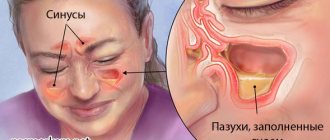The article was checked by an otolaryngologist
Natalya Aleksandrovna Naumova, Medis Clinic
Nasopharyngeal cancer is a malignant tumor in the pharynx, located in its nasal part. The prevalence of this disease ranges from 0.25% to 3% of all oncological pathologies of the ENT organs. It can develop in people regardless of their gender and age category. However, it most often affects men over 50 years of age. Success in the treatment of a malignant tumor can only be achieved with early detection and proper treatment.
Watch free online federal channels, watch via the link TV online
Reasons for the appearance of the tumor
Modern medicine has many types of diagnostic equipment that can recognize almost any disease and identify the cause of its development. However, experts have not been able to establish why a cancerous tumor forms in the nasopharynx.
Scientists have identified only a few factors that in one way or another can provoke the appearance of atypical cells in the nasopharynx area. These include:
- bad habits (smoking, alcoholism);
- eating meat and fish treated with salt;
- consumption of products containing carcinogenic substances;
- eating too salty, spicy, spicy foods;
- inhalation of harmful impurities (gas, dust);
- work in hazardous industries (cement production, paper and pulp industry);
- ionizing radiation;
- Epstein-Barr virus;
- autoimmune diseases;
- decreased protective functions of the body against the background of immunodeficiency.
Malignant neoplasms of the nasopharynx can occur due to irritating effects on the mucous membrane. Eating spicy, too hot and salty foods can provoke cell degeneration.
Specialists in the field of otolaryngology do not exclude the possibility of a hereditary predisposition.
Classification of the disease
Tumors can be benign or malignant. Benign neoplasms more often occur in children and adolescence, without threatening life. They are removed because the tumor makes it difficult to breathe through the nose, the process of swallowing food and worsens the quality of life of its owner.
Nasopharyngeal cancer is formed from epithelial cells. Considering that the epithelium consists of several types of cells, there are three main types of disease:
- squamous cell keratinizing carcinoma is the most aggressive type of cancer requiring immediate treatment;
- differentiated non-keratinizing carcinoma - a less aggressive type of neoplasm;
- undifferentiated nonkeratinizing carcinoma;
- basaloid carcinoma.
Other types of tumors, including sarcomas and lymphomas, can also affect the nose and throat area. However, they do not originate from epithelial tissue and therefore do not fall under the definition of “cancer.”
Stages of carcinoma development
Each type of carcinoma has several stages of development.
Stage 0. At this stage, atypical cells are detected in the nasopharynx area. Their danger lies in their ability to rapidly divide, penetrate other organs and destroy healthy cells.
Stage 1: Cancer cells begin to actively divide. Their accumulation leads to the formation of a node, the boundaries of which do not extend beyond the nasopharynx.
Stage 2. At this stage of nasopharyngeal cancer, malignant cells invade new territories of the body. This stage of the disease is divided into substages, which determine the direction of tumor spread. These include:
- 2A – the tumor grows into the soft palate, capturing part of the pharynx and nasal cavity;
- 2B – cells spread to the nearest lymph nodes.
Stage 3. This stage is due to the active division of cancer cells and tumor growth. Stage 3 of nasopharyngeal cancer is divided into the following substages:
- the first substage is characterized by a significant increase in the size of the tumor, penetrating into the tissues of the nasopharynx and cervical lymph nodes;
- the second substage is diagnosed if atypical cells penetrate the tissues of the middle pharynx, tonsils, base of the tongue and palate;
- the third substage is characterized by the penetration of mutated cells into the pharynx, as well as metastasis to the tissue of the palate, pharynx, and lymph nodes;
- the fourth substage develops with increased growth of the tumor, penetrating into the cervical bones and lymph nodes.
Stage 4: At this stage, nasopharyngeal carcinoma has invaded nearby tissues. Stage 4 is divided into the following substages:
- 4A further damage to the tissues of the nasopharynx occurs with tumor penetration into the cranial nerves;
- 4B – atypical cells penetrate the subclavian lymph nodes, due to which their size increases to 5-6 cm;
- 4C – metastases appear in neighboring tissues.
Classification of throat cancer
- From 60 to 70% of cases, cancer of the upper larynx is diagnosed in the vestibular and supraglottic zone.
- In 30-40% of patients, an oncological process of the middle part of the throat is detected in the fold area.
- In 2-5% of cases, oncologists register cancer in the lower subglottic region of the larynx.
Throat cancer is divided into stages, and the pathology is also classified according to the form of tumor growth into mixed, endophytic and exophytic type. The mixed subtype occurs in 18% of cases, endophytic cancer accounts for 29%. In most patients, up to 54% are diagnosed with an exophytic type of cancer in the lumen of the throat.
For a tumor originating in the supraglottic part of the larynx, the classification description will be as follows:
- T1. Only 1 anatomical part of the supraglottic part of the larynx was affected, and the vocal cords remained mobile.
- T2. The abnormal structure has invaded the mucous membrane or affected several areas of the supraglottic and ligamentous areas. Most often, cancer of the throat and tongue is diagnosed in this case.
- T3. The tumor has spread throughout almost the entire mucous membrane of the larynx and affected the vocal cords.
- T4a. A malignant neoplasm grows into the soft tissues of the neck or a secondary lesion is detected in the root of the tongue, thyroid gland or esophagus.
- T4b. Secondary tumor structures are found in the carotid artery, prevertebral space and mediastinum.
For the ligamentous department:
- T1a - the tumor structure has grown only within 1 vocal fold, which continues to move normally.
- T1b - the neoplasm is localized simultaneously on two folds, but their mobility has not yet been impaired.
- T2 - the tumor has begun to limit the mobility of the vocal cords or has grown into the subglottic or supraglottic region.
- T3 - the malignant structure does not extend beyond the larynx, but limits the mobility of the vocal cords.
- T4a - The tumor has spread to tissue outside the larynx.
- T4b - as with supraglottic localization, the tumor grows into the mediastinum, carotid artery or prevertebral space.
For the subglottic region:
- T1. The neoplasm is localized only in the subglottic region;
- T2. The vocal cords are affected by a tumor;
- T3. The malignant structure not only affected the vocal cords, but also spread quite widely throughout the laryngeal region;
- T4a. Abnormal cells grow into tissues in the immediate vicinity of the larynx, trachea, esophagus, cricoid or thyroid cartilage, thyroid gland;
- T4b. The prevertebral space, mediastinum and carotid artery are affected.
The letters NM have the same meanings as for any other oncological lesions - index 0 indicates the absence of metastases in the lymph nodes and internal organs, and numbers 1 or 2 indicate the presence of metastases.
We suggest you read what white dots on the lips mean and what to do about them
How to recognize the disease
The early stages of the disease are asymptomatic, making diagnosis difficult. Further, depending on the form and stage of the disease, three groups of manifestations appear:
- hearing aid symptoms;
- respiratory symptoms;
- neurological signs.
Ear symptoms that occur when the nasopharynx is affected include the following:
- pain in one or both ears (with bilateral damage);
- impairment of auditory perception;
- otitis;
- tinnitus.
The most common nasal symptoms are:
- violation of nasal breathing;
- characteristic nasal voice;
- nosebleeds;
- the exhaled air has an unpleasant odor;
- the appearance of a dense tumor;
- painful sensations in the nasopharynx, the appearance of which is not associated with an infectious disease.
Neurological manifestations include:
- constant headaches;
- speech disorders;
- disorders of chewing and swallowing functions;
- loss of sensitivity, paralysis of facial muscles.
Nasopharyngeal cancer is accompanied by neurological disorders in later stages, when the malignant tumor metastasizes to the base of the skull.
The absence of signs of the disease in the early stages leads to the fact that 80% of patients consult a doctor only when pain appears in the lymph nodes, indicating the appearance of metastases. The remaining part of the patients is diagnosed with distant metastasis.
Characteristics of nasopharyngeal cancer
Oxygen entering through the nose moves up into the nasopharynx. The apex of the organ is located in the intertemporal region at the same level as the root of the nose. The membranes of the nasopharynx are fine-fibrous muscle tissue. During inhalation, a noticeable resistance arises in the wings of the nose, which causes an irritating effect, due to which a reflex contraction of the pectoral muscles with the diaphragm occurs. At this time, a constant volume of the diaphragm is maintained.
The nasopharynx ensures this process for the body in an uninterrupted manner. An additional function of the organ is to maintain the elasticity of the lung system. The nasopharynx is similar to a leuko-shaped canal, the upper part of which completely grows into the bone tissue of the skull.
The neoplasm in the nasopharynx is malignant and develops from gametes of the upper pharynx. Occupies the area of the head and neck. Diagnosing the disease in the early stages is difficult due to the location of the organ. The ICD-10 code for pathology is C11.0 – C11.9.
The disease occurs at different rates in people of different races. Global statistics record the incidence within 0.25-3% of the total number of cancer pathologies. The disease is more common in the population of Southern China, Africa and South-West Asia - here the percentage is around 18%. The disease affects people after 50 years of age. Men suffer from the pathology more often; in women, the disease ranks third. It is necessary to treat cancer by combining the methods of oncology and otolaryngology.
How is carcinoma diagnosed?
Diagnosis of nasopharyngeal tumors requires a number of measures.
Visual inspection. When a patient consults a doctor with characteristic complaints, a visual examination is performed. Changes in the tissues of the throat are detected using a special mirror.
Next, the doctor palpates the throat and base of the neck, assessing the condition of the cervical lymph nodes.
Rhinoscopy. This research method is carried out using a rhinoscope, which allows you to examine the nasal cavity and detect a tumor. At this stage of diagnosis, the doctor has the opportunity to take a tissue sample for a biopsy.
X-ray examination. X-rays of the chest and skull base are performed in advanced stages of cancer if metastases are suspected in these areas.
Computed and magnetic resonance imaging. CT and MRI are the most revealing research methods, allowing to assess the degree of damage to the nasopharynx, the type of tumor, and detect metastases in the soft tissues of the head.
Neurological research. A neurologist identifies impaired coordination of movements, evaluates the patient’s intellectual abilities, muscle strength, and the functions of the sensory organs. This type of study is required to detect distant metastasis in brain tissue.
Lab tests. The patient takes blood and urine tests. Studying their composition allows us to obtain data on the general condition of the patient, develop optimal treatment tactics that can stop the pathological process and improve the quality of life.
PET method. Positron emission tomography involves the injection of radioactive glucose into the patient’s blood, which is actively absorbed by atypical cells. Thus, the doctor receives information about their prevalence and determines the stage of nasopharyngeal cancer.
How is nasopharyngeal carcinoma treated?
Nasopharyngeal neoplasms are treated in several ways:
- radiation therapy;
- radiological impact;
- chemotherapy;
- surgical intervention.
Features of radiation therapy
Radiation therapy is the main treatment for nasopharyngeal cancer. It consists of using beam radiation aimed at the area of the nasopharynx and neck. During the therapy, it is possible to destroy malignant cells and stop tumor growth. The disadvantage of radiation therapy is that it has a negative effect on healthy tissue.
Features of radiological impact
Radiotherapy has been successfully used in the treatment of nasopharyngeal tumors. The advantage of this method is the clearly directed impact of the beam, eliminating damage to healthy tissue. The disadvantage is that radiological exposure can only be used for small tumor sizes.
Features of chemotherapy
This method of treatment involves the introduction into the patient’s body of drugs that have a toxic effect. Under their influence, atypical cells die and tumor growth stops. However, under the influence of chemistry, healthy cells and tissues are also destroyed.
Chemotherapy destroys the immune system, gastrointestinal epithelium, bone marrow, and blood cells.
Features of surgical treatment
Surgical operations to remove nasopharyngeal carcinoma are performed very rarely, since they do not allow complete removal of atypical cells. The difficulty arises due to the close location of the base of the skull. Therefore, surgery is performed only if other treatment methods are ineffective.
Symptoms and manifestations of cancer at stages 3 and 4
Advanced throat cancer is accompanied by pronounced symptoms that bring painful sensations to the patient, which is associated with the extensive spread of the tumor and damage by abnormal cells not only to the mucous membrane, but also to the deep layers of the muscles of the laryngeal region, as well as their germination into nearby and distant internal organs.
- All changes in the body that occur in the final stages of the disease accompany specific symptoms of throat cancer:
- • severe pain in the laryngeal region;
- • the appearance of an unpleasant, putrid odor from the mouth;
- • constant, not associated with physical activity, shortness of breath;
- • partial numbness and deformation of certain areas of the neck and face;
- • a feeling of a foreign object in the throat that interferes with swallowing movements.
Pain in cancer that has reached the terminal stage of development can appear not only from the growth of the tumor structure and compression of the nerve roots. Quite often, pain occurs after courses of radiation therapy, causing burns of the skin and oral mucosa.
Forecast for life
The survival rate for carcinoma localized in the nasopharynx depends on the type of tumor and the extent of its spread. Of particular importance is tumor metastasis to the base of the skull and lymph nodes. An unfavorable factor is the patient's age exceeding the 50-year threshold.
The highest survival rate is in patients in the first two stages of the disease. It is 80-90%. About 70% of patients with stage 3 cancer survive. Every second patient survives the last fourth stage of the disease.
Stages of oropharyngeal cancer
Oropharyngeal cancer has five stages:
- • there is no early carcinoma as such, only single cancer cells are found in the epithelium;
- • the first is a tumor from 0 to 1 cm;
- • second - carcinogenic formation up to 2 cm and metastases in one or two lymph nodes;
- • on the third, carcinoma reaches 3–4 cm and metastasizes to multiple lymph nodes;
- • in the fourth (last degree) the cancer extends beyond the oropharynx, gives distant metastases, and disintegration is possible.
The duration of these stages and the dynamics of the manifestation of signs of the disease are individual - some live for years, while others burn out in a couple of months.
How to prevent the development of carcinoma
The main measure to prevent the development of nasopharyngeal carcinoma is to stop smoking and drinking alcohol. Constant irritation of the mucous membrane of the nasopharynx with alcohol-containing drinks leads to the degeneration of healthy cells. Intracranial translocation is one of the effective methods to help get rid of bad habits and avoid the development of carcinoma.
An important part of preventive measures is timely diagnosis of the disease. Therefore, it is important to undergo annual medical examinations to detect cancer at an early stage.
Symptoms and treatment of a tumor in the throat: signs of laryngeal cancer
Throat cancer is one of the most dangerous malignant tumors in humans. It is more common among men; risk groups include smokers and people aged 40 years and older. This disease is characterized by early metastases and occlusion of the lower and upper respiratory tract.
Today you will learn what the symptoms of throat cancer are and the characteristic signs of a laryngeal tumor, as well as the classification of this disease, stages, treatment methods and prevention.











